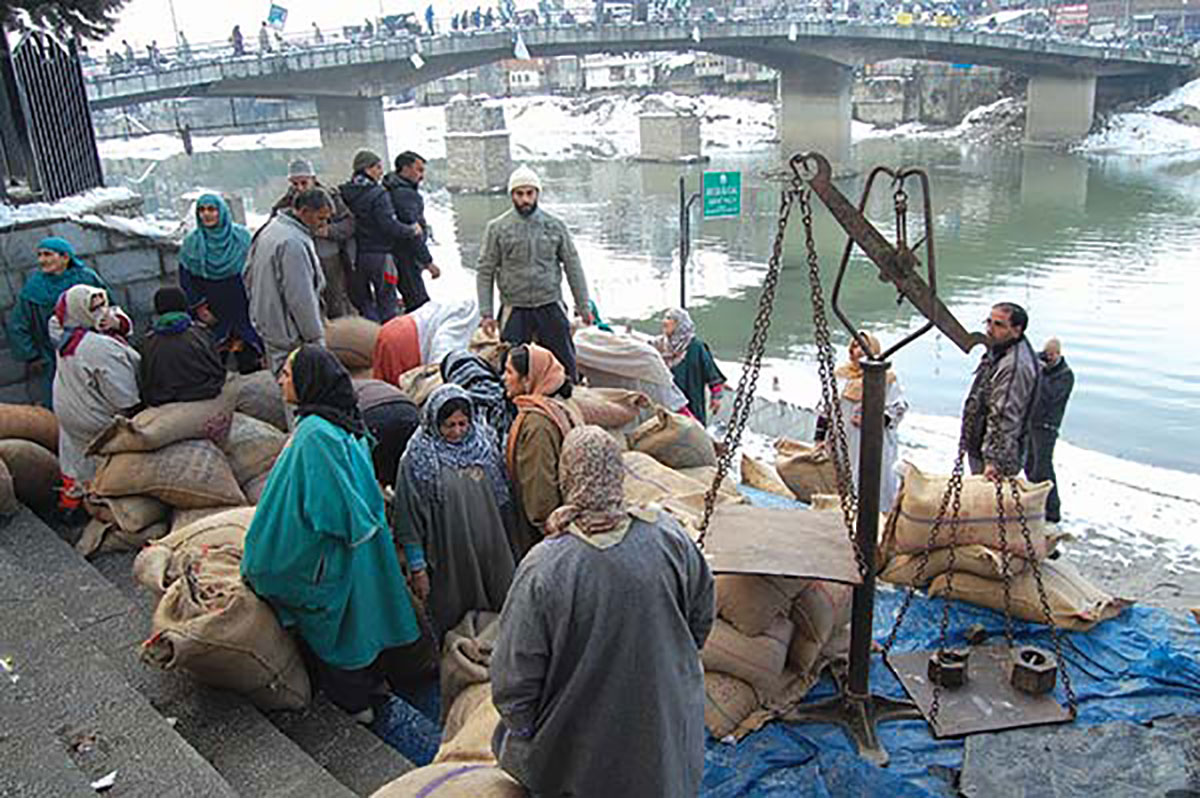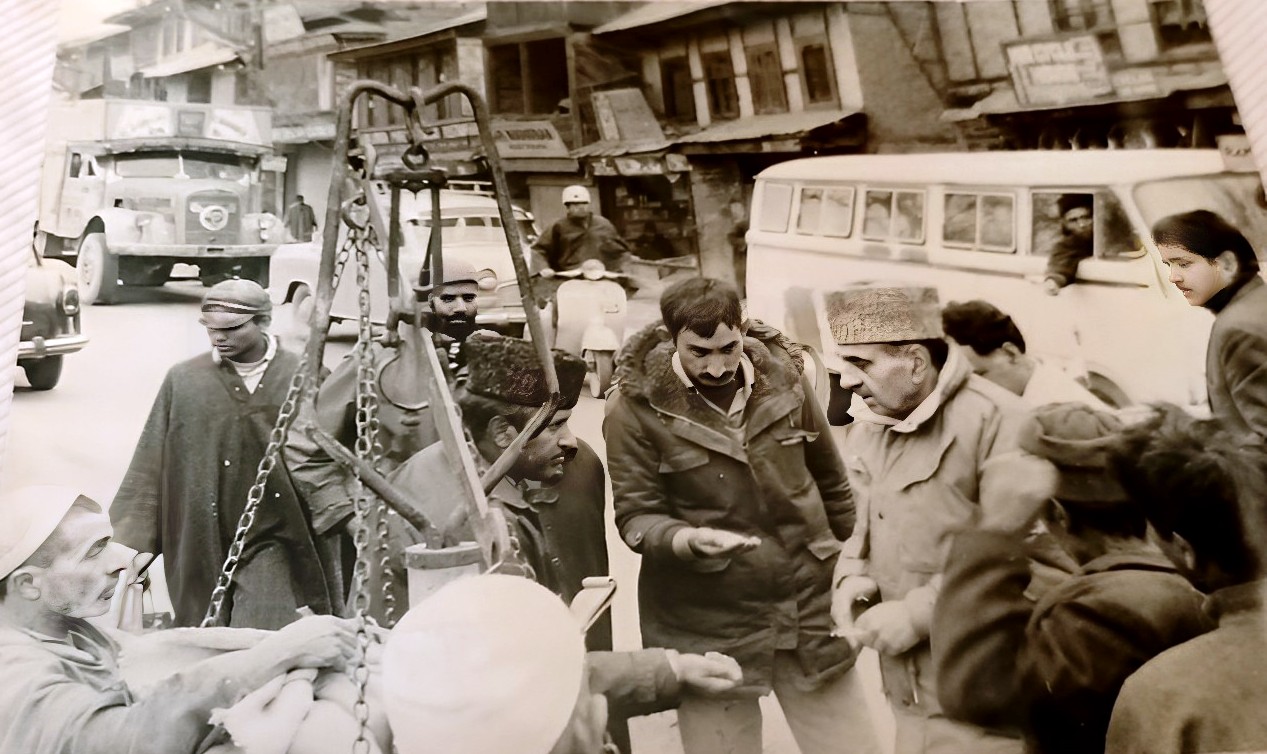As the government adjusts the food policies in vogue by reducing the per capita ration eligibility, Kashmiri families are facing a food shortage. Now, they will have to go back to the market and pay for their food, according to a report by Raashid Andrabi

In the food depot of Mehjoor Nagar, a group of women formed a human chain and chanted in unison, Batte Daadi Maerikh Kaeshir Musalman, Hai Toofan Hai Toofan (Kashmiri Muslims have been pushed to the wall for ration), expressing their frustration over the dire situation regarding ration supplies in Kashmir. The protest song is rooted in Kashmir’s exploitative Sikh and Dogra rule when the despots would seize the crops and sell them to consumers.
Scenes like Mehjoor Nagar are increasingly witnessed within and outside Srinagar these days. Women mostly use sarcastic folk songs to agitate against the new system in vogue. The population is not seeking free rations. Instead, they are demanding adequate rations.
“We don’t want handouts; we simply ask for the opportunity to purchase the amount of ration we require,” one protester articulated the sentiments of the crowd. “Surviving on a mere five kilograms of ration per head is simply not possible for us.”
Lately, the government has reduced the rice quota, a staple food in Kashmir, resulting in a sort of crisis, especially for the middle-class and low-income population.
The government’s decision to raise the prices of rice under the Jammu and Kashmir Food Entitlement Scheme (JKFES) has led to a significant decrease in the allocation of food grains, leaving the population in a state of shock and struggling to meet their basic need for an adequate food supply.
Rice, the staple food of Kashmir, has been a key political tool for centuries, especially after the decline of the Mughal era when rulers started taking most of the crop to fund their empires. Until 1947, the ruler would take most of the harvest as “its share” and sell it at exorbitant rates to the city dwellers to fill the coffers. This was the key reason for the officially implemented hunger that dominated Kashmir throughout Afghan, Sikh, and Dogra misrule.
Kashmir started consuming its own crop only after the partition when Sheikh Mohammad Abdullah implemented the sweeping land-to-tiller decision, restoring ownership to the peasantry that the ruler had usurped. Soon, his Deputy, Bakshi Ghulam Mohammed, seized power and saw a low-cost ration supply as a way out of being perceived as a villain and becoming a hero.
It was much later when the Food Corporation of India (FCI) became the key supplier to the erstwhile state’s Food and Consumer Affairs Department. With improved incomes and prosperity, the systems, as of late, started rationalizing the supply. The government is in a mood to gradually move out of the supply-demand chain so that market forces decide things. The process, however, is being seriously criticized as ensuring proper food supply to the people is a key function of the government.
The Current Crisis
The closure of the Jammu Kashmir Food Entitlement Scheme (JKFES) in September 2022 and the subsequent withdrawal of the Pradhan Mantri Garib Kalyan Anna Yojana (PMGKAY) later in December plunged the region into a severe ration crisis. The actions taken by the government can have serious consequences for the people of Kashmir, where rice is the main staple for the majority.
The Minister of Consumer Affairs, Food and Public Distribution, Piyush Goyal, announced the merger of the PMGKAY and the National Food Security Act (NFSA) on December 23, 2022. The merged scheme, called NFSA, had a budget of two trillion rupees, fully funded by the central government, intending to support over 8 million people until December 2023. However, instead of providing relief, this merger resulted in a reduction in the ration entitlement, from ten kilograms to a mere five kilograms per person.

The people of Kashmir believe that the allocated rice quota of five kilograms per person per month is grossly insufficient to meet their basic nutritional needs. Previously, they were receiving 15 kilograms of food grains, but now they will only receive five kilograms, creating a significant disparity in their food supply. This drastic reduction in ration entitlement has left the people of Kashmir struggling to meet their daily nutritional requirements.
The signs of decreasing ration allocations were evident even before the closure of JKFES. In early 2021, the total allocation of food grains (rice and wheat) for the Kashmir division under the three schemes – NFSA, JKFES, and PMGKAY – was 585,671 quintals (10 quintals make a ton). However, by August 2021, this allocation dropped to 510,000 quintals, indicating a decline in the availability of essential food supplies.
Under the Mufti Mohammed Sayeed Food Entitlement Scheme, which was later renamed JKFES following the revocation of Article 370, each person in Kashmir was entitled to five kilograms of rice, with an additional five kilograms provided under the PMGKAY. However, the closure of JKFES in September 2022 resulted in a further reduction in food grain allocation to 455,000 quintals. Subsequently, in January 2023, the allocation dropped further to 283,051 quintals, exacerbating the ration crisis in the region.
Official figures available with this reporter suggest that Jammu and Kashmir imported 7.06 lakh tons of rice in 2018-19, the highest in history. However, the imports dropped to 5.18 lakh tons in 2019-20. This deficit has had a profound impact on the livelihoods and well-being of the people, pushing them further into the grip of the ration crisis.
The Economic Survey 2023 has revealed that the government was providing food security to 24.66 lakh households. “2.28 lakh households are being provided food grains at the rate of 35 kg per family per month under Anatyodhya Aana Yojana (AAY), at the rate of 5 kg per person per month to 14.21 lakhs Priority Household (PHH) till December 2022,” it said. “8.17 lakhs Non-Priority Household (NPHH) were also covered under the National Food Security Act (NFSA), 2013.”
For January 2023, the allocation of food grains under the Antyodaya Anna Yojana (AAY) category included 30,457.95 quintals of rice and 1,321.60 quintals of wheat. Additionally, 70,701.04 quintals of rice were allocated under the Non-Priority Household (NPHH) category. While these allocations might seem substantial, they fall significantly short of meeting the overall demand and nutritional requirements of the affected population.
In December 2022, the government announced that rations would be provided free of charge for one year starting from January 1, 2023, to support the poor affected by the closure of PMGKAY. However, this decision of “free distribution” has not brought relief to the people in Kashmir, as the number of rations provided remains grossly inadequate.
Everybody Concerned
The ration crisis in Kashmir has sparked widespread concern among politicians in the region who have criticized the government’s handling of the situation. Ali Muhammad Sagar, the National Conference General Secretary, has lashed out at the administration for being too preoccupied with photo-ops and ribbon-cutting functions, failing to address the misery and suffering of the people.
Muntazir Mohiuddin, the Apni Party’s State Secretary and spokesperson has urged the LG administration to restore the previous ration scale of 20 kilograms per person to prevent black marketing activities and ensure the provision of rations to all consumers in Jammu and Kashmir across different categories.

PHOTO BY BILAL BAHADUR
Food Deficit
Historically, the last time Kashmir was growing enough for its own requirements was in the early twentieth century. As the weather would play a villain and the crops would frequently fail, the people opted out of rice and converted most of the paddy fields into apple orchards. This fetched them quick money and it started changing the economic profile of Kashmir.
Right now, the situation is that rice is grown only in places where there is no possibility of growing apples. It includes some areas in the plains of south Kashmir and north Kashmir. The rice fields in the city periphery have all been converted into housing establishments. This has added to the crisis.
With the FCI supplies falling and subsiding rations getting increasingly down, Kashmir is heading towards reliance on the market. The Galdar is back, finally.

